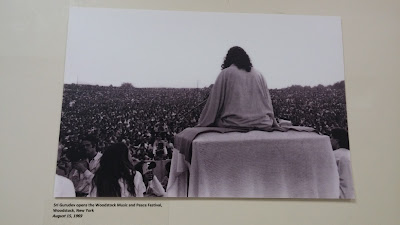 |
| Satchiananda at Woodstock – Opening Ceremonies |
4 days post-training and I am still feeling the love. I spent 6 days at Yogaville in Virginia with the beloved Nischala Joy Devi, immersing myself in Healing Relationships. This program is an essential part of my training as a yoga therapist. This being my first foray into the practice of Integral Yoga, I didn’t know what to expect. I had heard that Yogaville was a true ashram with monks, disciples and trainees of a guru named Swami Satchiananda (ananda meaning heart).
I came with a slightly open mind and heart to learn and immerse myself in their daily living. It was my past experience with organized religions, that clouded my initial immersion. With this in mind, I will share with you what Integral Yoga is, my experiences, and where I am going with this study.
“The Goal of Integral Yoga, and the birthright of every individual, is to realize the spiritual unity behind all the diversities in the entire creation and to live harmoniously as members of one universal family. This goal is achieved by maintaining our natural condition of a body of optimum health and strength; senses under total control; a mind well-disciplined, clear and calm; an intellect as sharp as a razor; a will as strong and pliable as steel; a heart full of unconditional love and compassion; an ego as pure as crystal; and a life filled with Supreme Peace and Joy.” (Swami Satchiananda).
Raja Yoga
Hatha Yoga
Bhakti Yoga
Karma Yoga
Jnana Yoga
Japa Yoga
When I first arrived at Yogaville, I was a bit unsettled, ungrounded. It took me a full 2 days to feel my feet on the ground (we were in the Blue Ridge Mountains by the way). It helped to go to a yoga class right away. The Hatha practice is a systemized sequence of poses, breath, concentration and relaxation to move the spine, direct energy, and let go. I didn’t take to it at first. Bhakti and Japa yoga still don’t resonate with me but I have been practice Japa daily since my return but would benefit from further reflection and practice. I have always had the idea of Karma yoga and service to others in my vernacular, so that yoga resonated for me. Jnana yoga is not quite there for me. I think further practice and reflection may?? help. And my daily concentration and meditation practice is certainly one that I can continue with. I believe that my ethics (8 limbs of yoga are consistent with Raja yoga.
Future Thoughts – I have heard that Integral Yoga is a useful and effective therapeutic application for healing and well-being. As part of my ongoing training and education and service to others, I plan on investigating these therapeutic benefits and seeing where and how they can be incorporated into my practice with my clients. Remember “Truth is one, paths are many”. There is no one right way.
If you want further information on this practice, check out the following website www.yogaville.org.
The Breath
Inhale “I am Calm”
Exhale “I am Here”
The Poses
Starfish Savasana Pose
Props: 2 or more blankets, neck rolls, eye pillow
Benefits: soothing to the nervous system, grounding, gentle chest opener, releases the pelvis
Lay a blanket on your mat for extra comfort and warmth, blankets for the arms as well. As you lay down, place your feet towards the corners of your mat and arms about 10-12 inches from your body, palms up. Add your eye pillow, and blanket on top. We adjusted the legs with our Double Dutch for optimal release of tension and proper alignment.
Childs Pose Variation





Leave A Comment